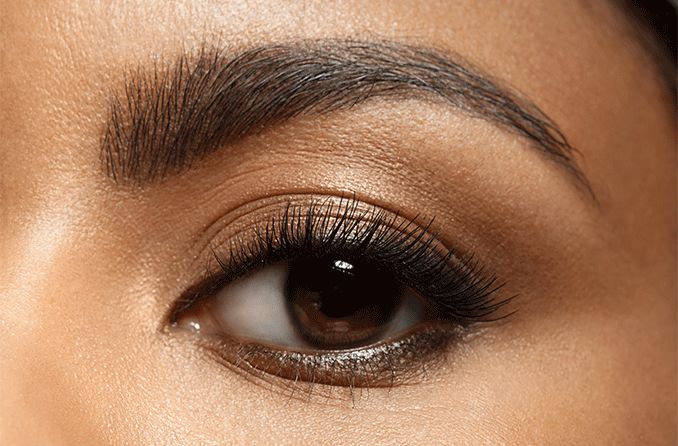Eyelashes: Definition, function and potential problems

Eyelashes are the small wisps of hair that line the edge of the eyelids. The purpose of eyelashes is to protect the eye from dust, debris, sweat and other elements that may harm or irritate it.
Eyelash definition
Eyelashes (commonly referred to as “lashes”) can be defined as the short strands of hair that grow at the edges of the eyelids.
The average human has 75 to 80 lashes on the bottom eyelid and 90 to 160 lashes on the top eyelid. Lashes grow at 0.12 to 0.14 mm per day until they reach their optimum length — usually 12mm or less — then fall out on their own.
Eyelash fullness and length varies, depending on genetics. Eyelash trichomegaly is a condition characterized by eyelash length that extends beyond 12mm. This trait can be inherited or may be a symptom of an underlying condition. In some cases, people with the condition must trim their eyelashes to avoid interference with their vision.
Though everyone’s lashes curve or curl to some degree, the amount of curl is determined by the same cells that affect whether a person’s hair is straight or curly. So, people with curly hair are likely to have eyelashes with a more dramatic curl, while those with straight hair are prone to having straighter eyelashes.
When removed forcefully — either by pulling or rubbing — it takes approximately eight weeks for the eyelash to grow back. Consistently pulling your eyelashes out can traumatize the lash follicle, which may prevent further growth.
Eyelash function
The primary function of eyelashes is to operate as a barrier between the internal and external eye. Especially when the eyes are closed, lashes work as a protective curtain to keep the eye moist and shield the cornea from outside elements.
Eyelashes are made up of dead cells containing keratin, a protein that is critical in hair, skin and nail growth. For this reason, the eyelashes themselves cannot feel any sensation. However, the base of the eyelash is full of nerve fibers that are extremely sensitive to pain, irritants and movement.
To understand how sensitive these nerve fibers are, reach up and touch the tip of your eyelashes. Even if you barely graze the ends of them, you will feel it instantly.
The heightened sensitivity allows the eyes to detect foreign elements like lint, dust or wind, and to respond accordingly by blinking or closing the eye. This automatic reaction is also why it can sometimes be difficult to keep your eyes open when applying contact lenses, makeup or false eyelashes.
SEE RELATED: Eyelash mites and eyelash lice
Conditions that affect eyelashes
Because eyelashes work as the eye’s first line of defense, it’s possible for them to be affected by infection (stye, blepharitis, etc.) or another condition, including:
Trichiasis — Eyelashes that grow inward, toward the eye.
Stye — Bacterial infection of an oil gland or eyelash follicle that results in a red, painful eyelid bump.
Blepharitis — Inflammation of the eyelid caused by bacteria.
Trichomegaly — Uncontrolled eyelash growth.
Madarosis — Condition that causes the loss of eyelash or eyebrow hair.
Distichiasis — Having two rows of eyelashes.
Epiblepharon — Condition that can result in eyelashes rubbing against the eye.
While some of these conditions cannot be avoided, keeping the area around the eye clean can reduce the chances of developing a bacterial infection. Washing the face, eyelids and around the eyes everyday, as well as avoiding touching the face and eyes unnecessarily, are just a few of the ways to prevent bacteria from spreading to the eyelids.
Wearing false eyelashes or receiving services such as eyelash extensions or tinting, can irritate the area around your eyelashes and cause infection. The glue used when applying false eyelashes or extensions can contain chemicals that may irritate the eye or trigger an allergic reaction.
Similarly, the formula used to tint lashes may have potentially harmful chemicals. In fact, the color additives used to tint eyebrows and lashes have not been approved by the FDA.
Before undergoing any services that involve your eyes and are not performed by a medical professional, it’s recommended that thorough research be done to understand potential complications and risks.
Importance of routine eye exams
If you notice any pain, redness, swelling or irritation along your lash line that persists for more than several days, you should see an eye doctor.
It’s also important to be mindful of any adverse reactions whenever you start using new contact lenses or eye drops, or whenever you’ve had cosmetic work done on your eyelashes, such as tinting or extensions.
An eye care professional can assess the symptoms affecting your eyelashes and determine the best treatment to offer relief and healing.
READ MORE: Latisse for longer eyelashes: Is it safe for your eyes?
Page published on Wednesday, February 3, 2021




